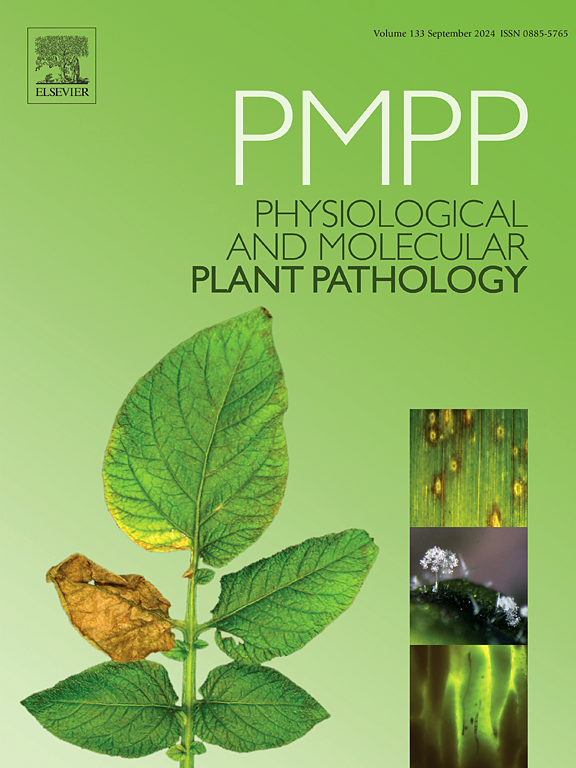Insights in to the genome sequence of an endophytic Bacillus amyloliquefaciens (TNOB22) from tea and its promising biocontrol activity against major diseases of tea
IF 2.8
3区 农林科学
Q2 PLANT SCIENCES
引用次数: 0
Abstract
Tea cultivation in South India is threatened by several foliar and root diseases. Use of fungicides for these diseases cause several health hazards to humans and develop fungicide resistance. In this context, the biological approaches by exploiting antagonistic bacteria especially Bacillus spp will play a vital role in managing the diseases and promote plant growth. Current study is focused on the isolation, identification, in vitro evaluation and whole genome sequencing of an efficient endophytic Bacillus amyloliquefaciens. The bacterial endophyte B. amyloliquefaciens (TNOB 22) significantly inhibited several pathogens causing tea diseases. The results of whole genome sequencing confirmed the isolate as B. amyloliquefacies with a genome size of 3.8 Mb with 46 % of GC content. The assembled genome consists 21 contigs with 3940 protein coding sequences (CDS); 59 transfer RNA (tRNA) genes and 2 ribosomal RNA (rRNA) genes. The genome has speciality gene clusters viz., aantibiotic resistance genes (53), drug target genes (48), transporter (191) and virulence factor genes (5). The isolate also has gene coding for several antifungal metabolites viz., bacillaene, bacillomycin D, bacilysin, macrolactin H, macrolactin B, macrolactin E, macrolactin 1C, mycosubtilin, paenibactin, paenilarvin A, paenilarvin B, paenilarvin C, fengycin, iturin, surfactin and plantazolicin. The pan genome analysis revealed the presence of increasing trend of pan genome represents the isolate could adopt to various ecological niches. These findings explored the biocontrol potential of B. amyloliquefaciens (TNOB 22) against major pathogens causing diseases on tea.
茶叶内生解淀粉芽孢杆菌(TNOB22)基因组序列的初步研究及其对茶叶主要病害的生物防治作用
南印度的茶叶种植受到几种叶面和根部疾病的威胁。对这些疾病使用杀菌剂会对人类健康造成若干危害,并产生杀菌剂耐药性。在这种情况下,利用拮抗菌特别是芽孢杆菌的生物学方法将在控制病害和促进植物生长方面发挥重要作用。目前的研究重点是高效内生解淀粉芽孢杆菌的分离、鉴定、体外评价和全基因组测序。内生细菌解淀粉芽胞杆菌(B. amyloliquefaciens, TNOB 22)对几种致病病原菌有显著抑制作用。全基因组测序结果证实该菌株为淀粉解相芽孢杆菌,基因组大小为3.8 Mb, GC含量为46%。组装基因组由21个contigs组成,包含3940个蛋白质编码序列(CDS);59个转运RNA (tRNA)基因和2个核糖体RNA (rRNA)基因。基因组具有特异性基因簇,即抗生素耐药基因(53个)、药物靶基因(48个)、转运基因(191个)和毒力因子基因(5个)。该分离物还具有抗真菌代谢产物的基因编码,即杆菌素、杆菌素D、杆菌素、大乳清H、大乳清B、大乳清E、大乳清1C、分枝杆菌素、paenibactin、paenilarvin A、paenilarvin B、paenilarvin C、风霉素、iturin、surfactin和plantazolicin。泛基因组分析显示,泛基因组呈上升趋势,表明分离物可以适应不同的生态位。这些结果探讨了解淀粉芽孢杆菌(B. amyloliquefaciens, tnob22)对茶叶主要病原菌的生物防治潜力。
本文章由计算机程序翻译,如有差异,请以英文原文为准。
求助全文
约1分钟内获得全文
求助全文
来源期刊
CiteScore
4.30
自引率
7.40%
发文量
130
审稿时长
38 days
期刊介绍:
Physiological and Molecular Plant Pathology provides an International forum for original research papers, reviews, and commentaries on all aspects of the molecular biology, biochemistry, physiology, histology and cytology, genetics and evolution of plant-microbe interactions.
Papers on all kinds of infective pathogen, including viruses, prokaryotes, fungi, and nematodes, as well as mutualistic organisms such as Rhizobium and mycorrhyzal fungi, are acceptable as long as they have a bearing on the interaction between pathogen and plant.

 求助内容:
求助内容: 应助结果提醒方式:
应助结果提醒方式:


